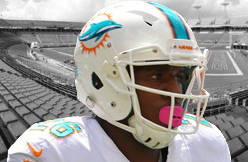Lamar Miller's 97-yard touchdown run started off inconspicuously.
The Miami Dolphins' third-year running back lined up to the left of quarterback Ryan Tannehill and went in motion behind Tannehill to the right. The ball was snapped, and a split second later, it was stuffed into Miller's midsection. Miller burst straight ahead through a gap in the New York Jets' front seven, cut to his right to avoid a defender and split the secondary by hitting the X button to accelerate.
It only took Miller 13 seconds to clear an entire football field—he began that highlight-reel run from inside his own end zone—and to show the world exactly what the Dolphins hoped he would do when they drafted him in the fourth round of the 2012 NFL draft.
But one cannot prove himself to be a workhorse in a quarter of a minute, and therein lies the biggest question facing both Miller and the Dolphins this offseason.
The Dolphins do not have a stocked cupboard of proven talent on their running back depth chart, instead sporting a short list of inexperienced high-upside prospects.
On one hand, the constitution of their stable of backs is indicative of their evolving offensive philosophy, which focuses on a precision passing game to move the ball downfield with efficiency through high-percentage plays. On the other hand, the harrowing fact is that the Dolphins are an injury away from having nowhere to turn when Tannehill needs to turn around and hand it off.
That's especially concerning considering the consternation over Tannehill's development and progression from a second-rate quarterback to a franchise signal-caller.
He's made that progress slowly over the course of his career, but entering the fourth year of his rookie deal—and with the Dolphins facing a big decision over whether to exercise the fifth-year option in his contract—it's time for the Dolphins' passer to fish or cut bait, and it's time for the organization to do the same with regards to Tannehill.
Independent of that inquietude, the Dolphins must ask themselves whether Miller has what it takes to be the focal point of their running game to take as much pressure off Tannehill as possible.
Miller has most of the skills he will need to be a bellcow, with versatility to play both in the running game and in the passing game as well as the kind of home run potential that forces linebackers and safeties to respect the run, thereby helping the Dolphins execute their offense by opening up the short and intermediate windows in the passing game.
He has also been serviceable in pass protection, though he could stand to improve. He ranked 30th out of 62 running backs in Pro Football Focus' pass-blocking efficiency in 2014, after ranking 14th out of 54 in 2013.
Where Miller struggles most is running between the tackles. The Dolphins know that they need to find someone who excels at taking the ball into a pile of people and still gaining positive yards.
"Yeah, that's something that we're always looking to do and bring those types of guys in," Dolphins general manager Dennis Hickey said when asked whether his team would be looking to the draft for the thunder to complement Miller's lightning. "We're always looking at whatever avenues we can to bring in better players."
Assuming Miller can't pick up short yardage is just lazy. In 2014, the Dolphins converted 11 out of 15 (73.3 percent) of their 3rd-and-1 rush attempts for either a first down or a touchdown (10th in the league), with Miller picking up nine of his 10 tries on 3rd-and-1. They converted 26 out of 35 (74.3 percent) of all runs with one yard remaining for a first down (eighth in the NFL), and Miller moved the chains on 18 of his 21 tries with one yard to go.
With three yards or less to go, the number dips to a modest 63.6 percent—42 out of 66, 16th in the NFL. Miller was successful on 25 of his 40 rush attempts with three yards or fewer to go.
Even still, it would be nice to have an extra back to absorb that punishment so Miller doesn't have to.
The Dolphins could use to round out their depth chart, but that's not the question. The bigger question is consistency. Despite carrying the ball 216 times (15th in the NFL, 13.5 per game), Miller picked up more than 100 rushing yards in a game on only two occasions and more than 70 yards on only five occasions in 2015. That was despite being the Dolphins' leading rusher by a whopping 160 carries more than their second-leading rusher: their quarterback.
Forty-four carries for veteran Daniel Thomas generated 168 yards, and 36 carries for Damien Williams yielded 122 yards, barely putting a dent in the Dolphins' offensive production.
Miller could be asked to carry the ball upwards of 250 times in 2015, so the Dolphins may want to draft a between-the-tackles hammer simply to avoid an ignominous fate in short-yardage situations. The hallmark of so many finesse teams is their ability to kill you with a thousand paper cuts, but their weakness is the inability to wield the heavy artillery it takes to finish the job when papercuts cannot.
We've already seen that Miller has the potential to be the focal point of a rushing attack, but as his role increases, so does the spotlight—and so does the amount of tape which opponents can study to exploit his weaknesses. Miller will continue to make life difficult for opposing defenses, but he needs to become more consistent in the face of more touches in order to be more than just a complementary piece to the passing game.

(bleacherreport.com)



